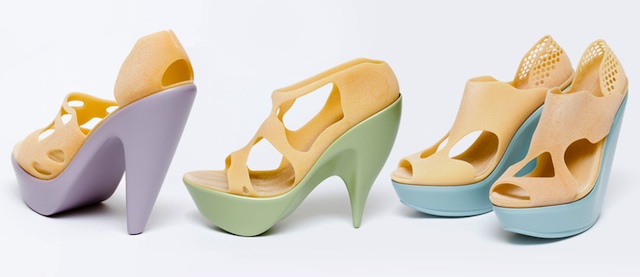3D printing is making significant inroads into the world of fashion. It is not, perhaps, the most obvious industry sector with which you would associate this technology, and yet, once again it is the key advantage of customisation and producing complex geometries that has this industry hooked when it comes to 3D printing.
The Fashion Digital Studio, which was an exhibitor at the 3D Printshow earlier this month, is an industry leader in the field of digital technologies and is fully dedicated to supporting the convergence of technology-based industries and fashion by driving technology into the economic and skills agenda. Practically, the Fashion Digital Studio brings together designers, academics and industry leaders to challenge how technology development and digital strategy can be applied within creative industries. This is accomplished through a combination of direct consultancy, knowledge transfer and continued innovation.
I caught up with Peter Hill at the 3D Printshow last week — even despite the queues of fascinated visitors at the Fashion Digital Studio stand who were just enthralled by the possibilities of 3D printed fashion and accessories. I was guilty of some ‘oohing’ and ‘aahing’ myself, as I’m sure you can imagine.
Peter indicated that the Studio is actively involved in the development of academic AND commercial innovation through dedicated research and development. Furthermore, the aim is to drive applicable technologies — which includes 3D laser scanning and 3D printing — further into the fashion and textile industries. Peter commented, “3D Printing along with 3D scanning will enable artists and designers to escape the confines of twentieth century industrial forms. 3D Print allows complexity, we can return to the kind of intricate work seen in arts and crafts, Rocco and baroque — only this time it will be combined with new processes of digital sampling and ‘Cut Paste Copy’ design. What happened to music with samplers and synths in the 80’s can happen to design and industry now.”
As mentioned earlier, one of the benefits is the value of customisation when applied to certain apparel that makes this so exciting — think shoes that fit your foot precisely — of which there were some great examples on show — or, a hat that fits your head exactly, coming next year I was informed. I managed not to squeal.
Peter further explained, “We will have ease of access to next generation 3D scanners embedded in cameras and mobiles, simple 3D scanning is already happening right now with mobiles. (Autodesk 123Catch App on iPhone) add this to low-cost 3D printing and we can make, copy and customise anything. Furthermore, young fashion designers are hungry for new processes and new materials, our students are eager to start incorporating 3D printing into their creations.”
In terms of customisation, it can be applied for functionality as well as taste. For example, using 3D scanning techniques the relevant part of your body can be scanned to produce an exact 3D digital model of it. Let’s go with your feet. From this 3D information it is then possible to design tailor made footwear that will accurately fit your feet in a quite unique way. The implications for this sort of application are phenomenal for sports and leisure activities (correct support and comfort, thereby avoiding injuries) right through to unique fashion statements. And talking of fashion as a statement think one-off designer bags right down to buttons on a shirt (there were some on show) — 3D printing is raising the stakes in the fashion industry.
In terms of the future, Peter has great vision: “I expect the next wave of 3D printed design to be more subtle, matured with increasingly sophisticated blending of the new and the traditional. Then we have designs that are comfortable, durable, unique and unquestionably twenty-first century.”




